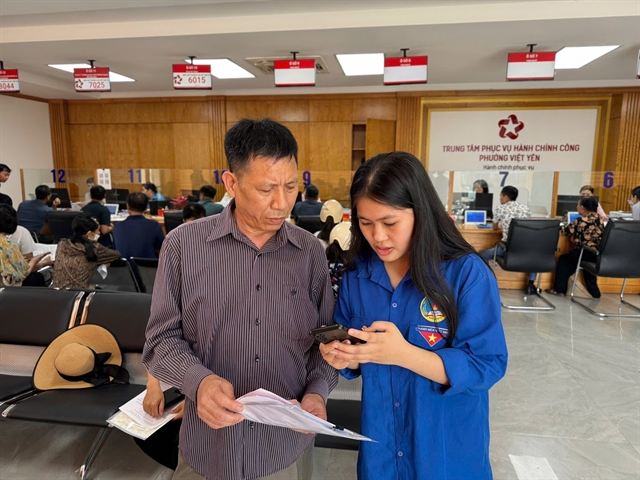 Economy
Economy

Electronic wallet (e-wallet) services are becoming more popular in Việt Nam, with a number of new e-wallet services officially licensed in the last year and a half.
.
 |
| A person uses the MoMo e-wallet. E-wallet services are becoming popular in Việt Nam. - Photo momo.vn |
HCM CITY — Electronic wallet (e-wallet) services are becoming more popular in Việt Nam, with a number of new e-wallet services officially licensed in the last year and a half.
Over the next five years, 24 per cent of banks’ market share in remittances and payments are expected to belong to financial technology companies (fintech), according to a global survey by PricewaterhouseCoopers (PwC).
E-wallets are electronic accounts that allow users to pay online bills and service fees, and transfer money and receive money quickly.
As an online payment form, through a mobile device, e-wallets help users make payments anywhere at anytime, saving money and time compared to other forms of payments.
In remote areas, where transaction offices and commercial banks are not present, e-wallets are especially useful.
The e-wallet market has become more active with competition among major service providers.
To compete with commercial banks and traditional e-wallets, the WebMoney e-wallet has launched a global version in Việt Nam after five years of operation with many new features, such as money transfer and global shopping.
Meanwhile, the VietUnion Online Services Corporation (VietUnion) with its Payoo e-wallet service has raised capital to VNĐ150 billion (US$6.6 million) after transferring 40 per cent of its stake to the Japanese company NTT Data.
The MoMo e-wallet has a wide network with 3,000 transaction points, 100,000 retail outlets and about 500,000 customers.
Việt Nam has about 10 million customers using e-wallets from 10 service providers, using internet and mobile devices, according to experts.
Ngân Lượng, Payoo and MoMo are among the e-wallets being used.
The State Bank has also licensed an intermediary payment service for WePay, a payment service company.
Last year, a number of companies operating in the field of payment services, including e-wallet services, were licensed.
These companies must comply with regulations on safety and security of equipment for bank card payments and regulations to ensure confidentiality and privacy.
Many commercial banks are also cooperating with e-wallets to create more added value services for customers.
For example, the Bank for Foreign Trade of Việt Nam (Vietcombank) has expanded its cooperation with VietUnion to use Payoo e-wallet services.
Any individual and organisation can carry out transactions via the Payoo e-wallet and select from many convenient transaction channels at Vietcombank.
At Payoo e-wallet, customers can charge a limit of VNĐ50 million ($2,200) per day, and withdraw a maximum of VNĐ20 million ($880) per day.
Other commercial banks are also using e-wallet services.
According to a representative from the LienVietPostBank, Ví Việt is a non-cash payment online tool that helps customers pay bills and shop online.
As of the end of April, after one year of operation, Ví Việt had about 1.2 million accounts with 5,000 payment acceptance points nationwide.
The head of LienVietPostBank said by the end of this year there would be 2.5 million customers opening Ví Việt accounts and more than 10,000 payment acceptance points nationwide.
Nguyễn Thanh Hưng, chairman of the Việt Nam E-commerce Association, said during the last five years nearly 20 e-wallets had been in operation but only a handful of them had survived.
With a high percentage of internet users (44 per cent) and 143 million mobile subscribers and more than 30 million Facebook users, e-wallets have great potential in the country.
If banks do not invest in technology innovation, the electronic payment market will fall into the hands of electronic wallets and fintech companies, Hưng said.
Fintech companies have become a threat to banks. If banks do not use advanced technology, traditional payment methods may begin to lag behind within the next few years.
Dr. Huỳnh Trung Minh said the development of e-wallet services provides a convenient payment channel for customers.
However, the local habit of using cash, along with security-related barriers, prevents many people from using e-wallets as a payment channel.
In order for e-wallet services to thrive in the future, commercial banks and payment service companies need to cooperate.
According to Circular 39 issued by the State Bank, e-wallet services are officially recognised as a payment service like other collection and payment services.
The e-wallet was introduced in Việt Nam in 2008 when an urgent need for payment methods for e-commerce activities emerged.
With the e-wallet service, users only need a mobile phone to pay bills or take part in e-commerce activities. — VNS




